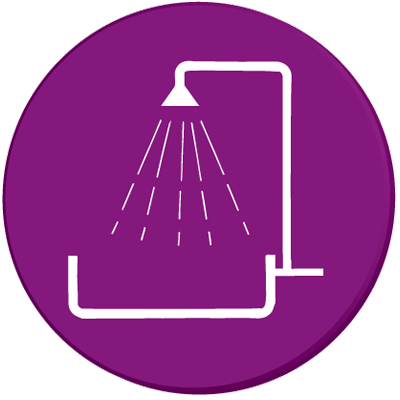SOP 7: Decontamination
PROCEDURES
7.1 Preparation
Before executing the rescue operation in the Hazardous and Noxious Substances (HNS) incident, the basic requirements for the decontamination station should be ensured. The decontamination station should be located upwind from the actual incident and have the features for effective operation (e.g. access to the hot zone, a usable water supply, the possibility to collect contaminated liquids and waste) and access to first aid facilities to ensure the prompt commencement or continuance of emergency medical care.
Finding out the HNS involved and possible specific decontamination processes is essential to ensure an effective and sufficient decontamination process. The number of contaminated persons, the type of contamination and the number of casualties on board the distressed vessel (DV) should be clarified to have recourses for carrying out planned tasks.
7.2 Establishing phase
When establishing the decontamination station, an adequate number of assisting personnel and the required level of personal protective equipment (PPE) available should be confirmed. All areas where the decontamination process takes place should be clearly marked and guided (e.g. clean and unclean sites). Service and treatment facilities should be established in the cold zone. Access to the cold zone from the decontamination station should be organised to ensure a reliable decontamination process and prevent secondary contamination.
7.3 Decontamination processes
7.3.1 Emergency decontamination
Emergency decontamination should be carried out as soon as possible to minimize the effect of the HNS by removing contaminant from casualties. A basic procedure is to have an effective decontamination process for casualties without any personal protective clothing. Emergency decontamination can be carried out at the decontamination point, which can be fixed or portable. That can also be done through the mass decontamination line or through the responder decontamination procedure. Lifesaving medical measures have priority over (coarse) decontamination. Self- protection of the assisting and medical personnel must be assured. Notice that due to the risk of secondary contamination; only patients who have been decontaminated will be transported. Confirm that receiving hospitals are informed and have the capacity to respond to the situation.
7.3.2 Responder decontamination
The decontamination process consists of both physical and chemical methods to minimize the impact of the possible contaminant. Responder decontamination is a basic procedure to have an effective decontamination process mainly for rescue workers wearing personal protective clothing and equipment.
The responder decontamination process can be divided into different stages, e.g. first stage decontamination, second stage decontamination, check-up point, and a final phase decontamination which includes packing up contaminated PPEs, etc.
7.3.3 Search and rescue unit (SRU) and equipment decontamination
The possibilities and procedures to decontaminate the SRU and equipment are highly dependent on the type, quality and quantity of the HNS involved. When assessing the possibilities to arrange decontamination for the SRU or equipment, it is important to consult professionals to find out the process needed for the decontamination. In some situations, decontamination of the vessel or equipment can be very expensive and time-consuming. Special equipment inventory (e.g. detection and monitoring equipment used in the incident) should be done and documented separately for each device used.
7.3.4 Decontaminated waste
The facility and containers, etc., on board should be established for contaminated waste such as equipment, clothing and fluids. Plan and arrange for appropriate handling of the contaminated waste ashore before arriving at the port of destination.
